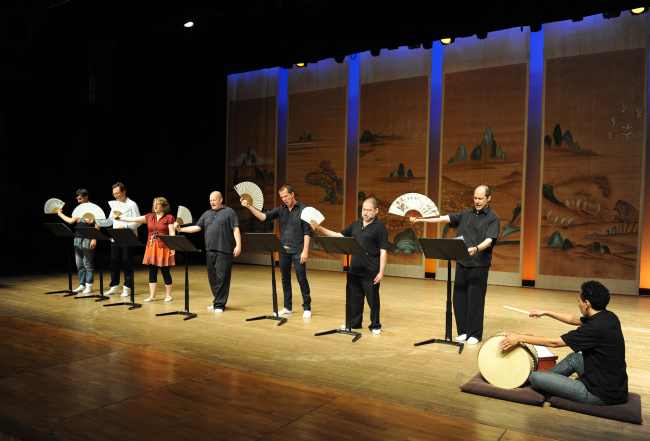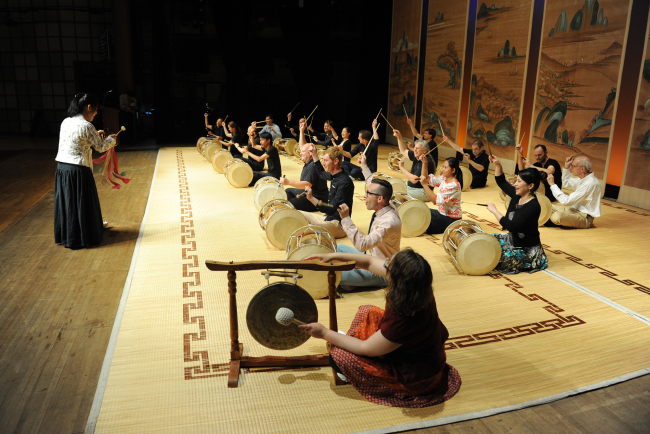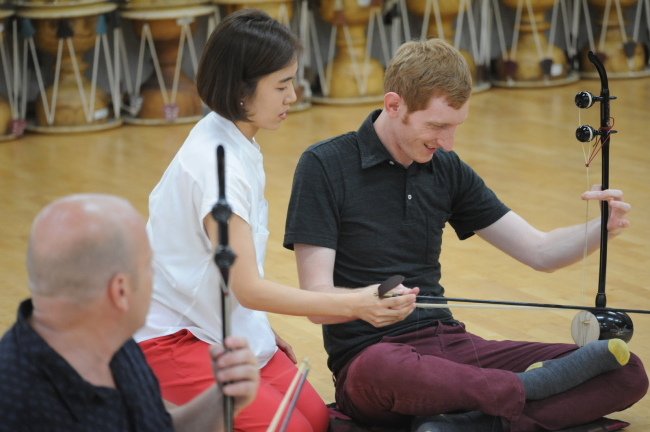Foreigners learn traditional Korean music
National Gugak Center holds International Gugak Workshop for musicians and academics from around the world
By Korea HeraldPublished : June 29, 2014 - 20:49

Inside a classroom at the National Gugak Center in Seocho-dong, Seoul, on Friday, a group of people sit upright and cross-legged on the hardwood floor, bringing out melodies with traditional Korean instruments such as the gayageum and haegeum.
In another room, people passionately learn how to bellow out “pansori,” a type of sung Korean folk narrative, while snapping open and shut traditional fans in rhythm with impromptu short verbal sounds made by a buk (drum) player.
It is a common sight at the nation’s primary institution dedicated to the Korean traditional performing arts, or “gugak,” except this time, the participants were all foreign.
They were taking part in the “International Gugak Workshop,” an annual program hosted by the center which invites creative artists and academics who study music from around the globe to experience and learn the art of gugak for two weeks.
The institution selected a total of 17 international musicians, composers and academics to join this year’s edition. Initially, most of the participants found out about the workshop through Korean friends and industry connections. The 17 attendees come from diverse countries including the United States, France, Austria, Japan and South Africa, among others.
“There was a wonderful balance struck between academic learning and practical engagement with the instruments,” said participant Jared Redmond, an American pianist who studies Western classical music at Brandeis University. “By learning how to play the instruments ourselves, we were able to really understand how Korean instruments sound, how they work and how difficult it is to perform in a certain way.”

The program offered both academic and hands-on lessons delivered by professional gugak artists from the center. On Friday, the last day of the workshop, which began on June 16, the international party ― most of whom had limited experience with gugak prior ot the workshop ― staged impressive performances with pansori, haegeum, gayageum, janggu and gomungo, showing each individual’s hard work and deepened knowledge of gugak.
The participating creative artists said that they discovered certain aspects of Korean instruments and music forms that were personally attractive, both aesthetically and philosophically.
“Pansori was the most interesting to learn, given that it is a musical style that does not exist in the West. It is music which is very close to the people and their sentiments,” said Sebastian Gaxie, a composer, pianist and film director from France. “I personally think it is one of the best ways to sing in the world,” said the composer.
“I think there is a unique kind of roughness to the sound in almost all traditional Korean music. For instance, the tone of the daegeum and the way it buzzes ... you don’t have anything like that in the West. Same goes for pansori vocal style and other traditional instruments,” said Redmond, a pianist who focused on learning the haegeum during the program.

“The instruments and their playing techniques show that there is a mixture of elegant, graceful beauty and a certain kind of grit ― a type of pain that lies underneath the tone, (which is) quite unique to gugak,” he added.
The participants plan to take home what they have learned from the workshop to apply it to their future endeavors, be it in academia or creative productions, as they return to their respective fields and countries.
“I’ll certainly include a section on Korean music in the ethnomusicology courses that I am teaching,” said Theodore Levin, an American professor of musicology at Dartmouth College. “And I very much hope to be able to invite musicians from the gugak center to come and be resident artists at Dartmouth and maybe teach a class on Korean music,” the ivy league professor added.
“My hope is to return to Korea soon to write a piece for (the National Orchestra of Korea,) the nation’s traditional instrumental orchestra,” said Gaxie, who also has plans to put together a documentary about Korea and gugak when he returns to France.
The “International Gugak Workshop,” organized by the National Gugak Center, has been running since 2001 to promote traditional Korean music overseas. A total of 140 participants from 27 countries have attended the workshop so far, and have contributed to the globalization of gugak through diverse routes such as books on pansori, university lectures and establishing gugak orchestras in their countries.
By Sohn Ji-young (jiyoung.sohn@heraldcorp.com)
-
Articles by Korea Herald


![[AtoZ into Korean mind] Humor in Korea: Navigating the line between what's funny and not](http://res.heraldm.com/phpwas/restmb_idxmake.php?idx=644&simg=/content/image/2024/04/22/20240422050642_0.jpg&u=)

![[Exclusive] Korean military set to ban iPhones over 'security' concerns](http://res.heraldm.com/phpwas/restmb_idxmake.php?idx=644&simg=/content/image/2024/04/23/20240423050599_0.jpg&u=20240423183955)

![[Herald Interview] Why Toss invited hackers to penetrate its system](http://res.heraldm.com/phpwas/restmb_idxmake.php?idx=644&simg=/content/image/2024/04/22/20240422050569_0.jpg&u=20240422150649)
![[Graphic News] 77% of young Koreans still financially dependent](http://res.heraldm.com/phpwas/restmb_idxmake.php?idx=644&simg=/content/image/2024/04/22/20240422050762_0.gif&u=)







![[Exclusive] Korean military to ban iPhones over security issues](http://res.heraldm.com/phpwas/restmb_idxmake.php?idx=652&simg=/content/image/2024/04/23/20240423050599_0.jpg&u=20240423183955)



![[Today’s K-pop] Ateez confirms US tour details](http://res.heraldm.com/phpwas/restmb_idxmake.php?idx=642&simg=/content/image/2024/04/23/20240423050700_0.jpg&u=)